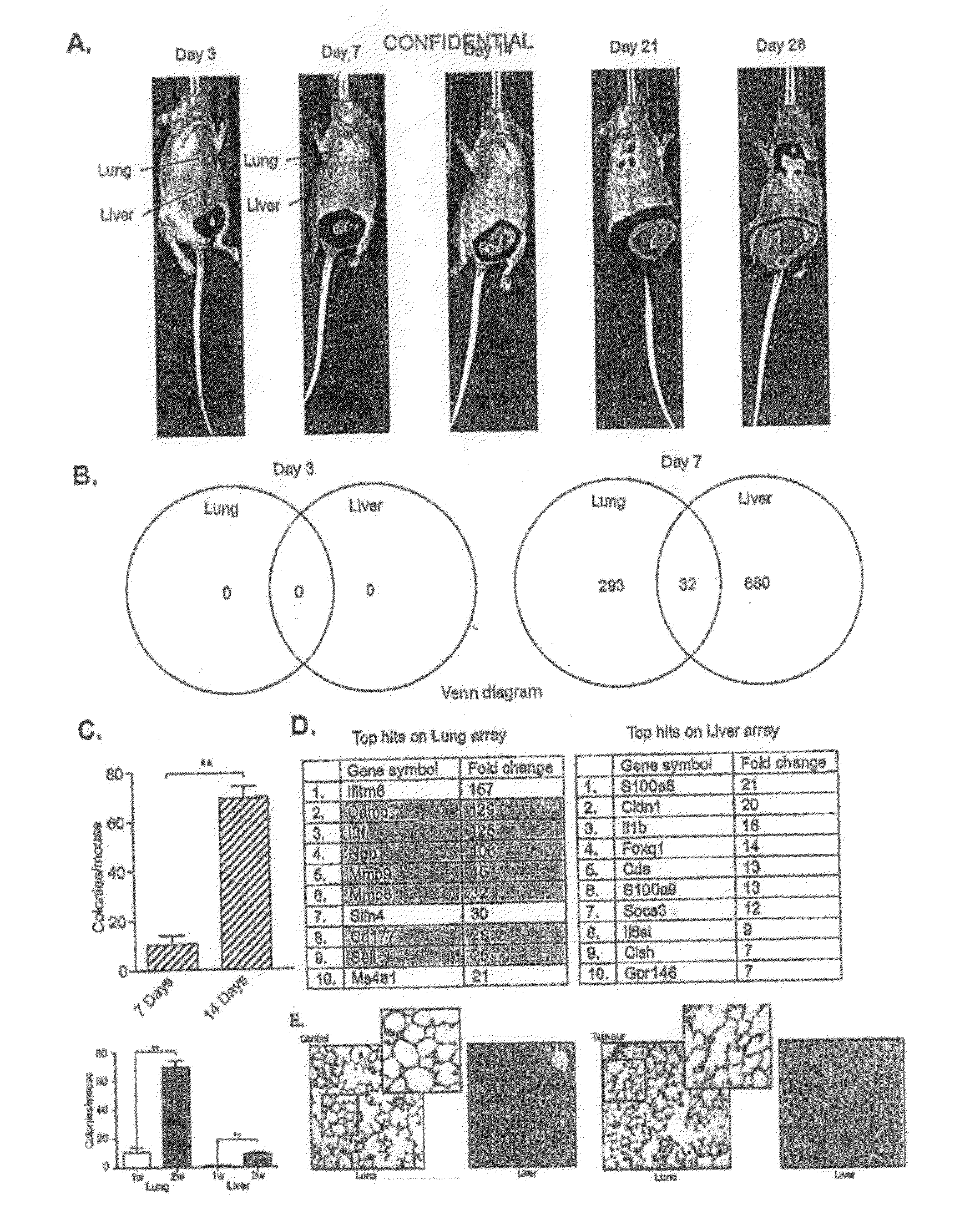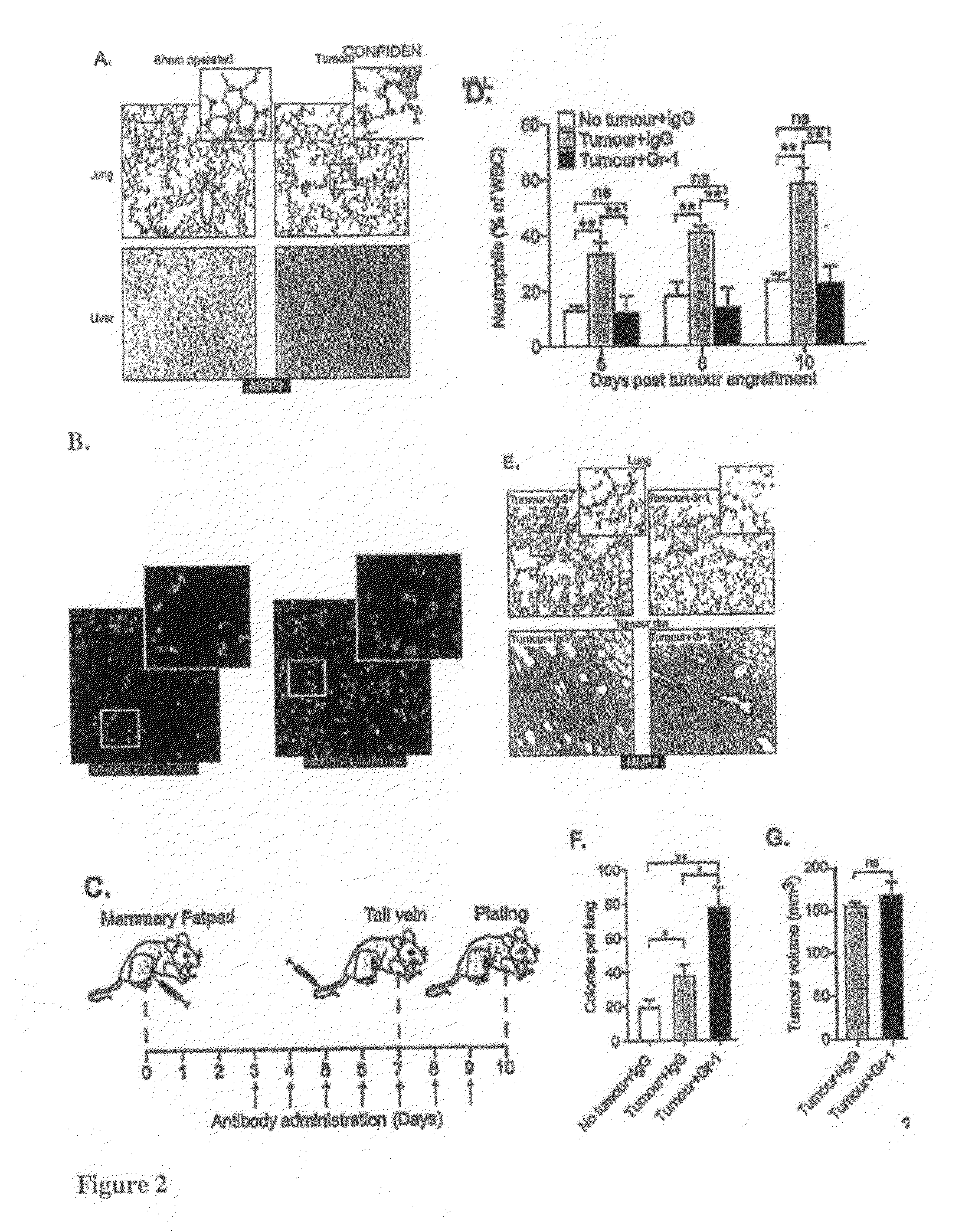Use of entrained neutrophils to treat metastatic and micrometastatic disease in at risk patients
a technology of metastatic and micrometastatic disease, which is applied in the direction of drug compositions, peptide/protein ingredients, other blood circulation devices, etc., can solve the problems of difficult differentiation, multiple factors which drive the progression of metastasis, and have not been fully elucidated
- Summary
- Abstract
- Description
- Claims
- Application Information
AI Technical Summary
Benefits of technology
Problems solved by technology
Method used
Image
Examples
example i
[0238]This example describes exemplary materials and methods used during the development of the present inventions.
Animals: Nude, Balb / C, C57 / B16 and Balb / C-Ubc-GFP were purchased from Taconic,
Jackson lab and Harlan. Experiments involving animals were approved by Memorial Sloan-Kettering Cancer Center's Institutional Animal Care and Use Committee (IACUC).
Cell lines: 4T1, B16-F10 and Lewis Lung Carcinoma (LLC) routine tumour cell lines as well as the human MCF7 mammary cell line were purchased from the ATCC. The human 4175 (LM2) cell line. CCL2 and CCL5 knockdown 4T1 cells were generated by lentiviral transduction with CCL2 and CCL5 specific shRNAs from the SKI shRNA lentiviral collection.
Spontaneous metastasis assay: Nude female mice were orthotopically injected with 5×106 luciferase labeled cells. Metastatic progression was monitored using IVIS200 imaging system to measure lung specific luciferase activity starting on day 3 post tumour engraftment.
Microarray: Nude female mice were ...
example ii
[0240]This example demonstrates changes in gene expression at premetastatic locations.
[0241]The 4T1 routine mammary tumor model was employed to gain insight into the early transcriptional changes that take place in the pre-metastatic niche. Orthotopically implanted 4T1 tumors spontaneously metastasize primarily to the lung whereas metastases to the liver, brain, and bones are less frequent and arise much later (FIG. 1A). mRNA microarray analysis of lung and liver samples from tumor-bearing versus sham-operated mice shows no significant differences in gene expression 3 days after turnout engraftment. In contrast, 325 and 912 genes were significantly misregulated in the lung and liver (respectively) of turnout-bearing mice 7 days after tumor engraftment (FIG. 1B). Of the 325 lung misregulated genes, 293 were lung specific and were not misregulated in the liver. Merely a small number of tumor cells were found in the lungs at this point suggesting that tumor-cell contribution to the exp...
example iii
[0243]This example shows exemplary MMP9+ cells present in the pre-metastatic lung. MMP9+ cells have neutrophil markers.
A dramatic increase in cells staining positive for MMP9 were seen in the pre-metastatic lung but not in the liver (FIG. 2A). The increase in MMP9 staining was not unique to the pre-metastatic lungs of 4T1 tumour bearing mice but was also found in mice bearing other pre-metastatic xenografts and in spontaneous tumor models (FIG. 6). Interestingly, there was no increase in MMP9 staining in mice with orthotopic MCF7 tumours, which fail to colonize the lung.
[0244]The inventors contemplated that MMP9+ cells present in the pre-metastatic lung might be neutrophils as several neutrophil-specific genes (such as cathelicidin and lactoferrin) are acutely upregulated in the pre-metastatic expression array (FIG. 1D). Immunohistological analysis performed on pre-metastatic lung tissue shows that the MMP9+ cells in the lungs co-stain with the neutrophil marker Ly-6G (FIG. 2B) but ...
PUM
| Property | Measurement | Unit |
|---|---|---|
| diameter | aaaaa | aaaaa |
| concentration | aaaaa | aaaaa |
| concentration | aaaaa | aaaaa |
Abstract
Description
Claims
Application Information
 Login to View More
Login to View More - R&D
- Intellectual Property
- Life Sciences
- Materials
- Tech Scout
- Unparalleled Data Quality
- Higher Quality Content
- 60% Fewer Hallucinations
Browse by: Latest US Patents, China's latest patents, Technical Efficacy Thesaurus, Application Domain, Technology Topic, Popular Technical Reports.
© 2025 PatSnap. All rights reserved.Legal|Privacy policy|Modern Slavery Act Transparency Statement|Sitemap|About US| Contact US: help@patsnap.com



